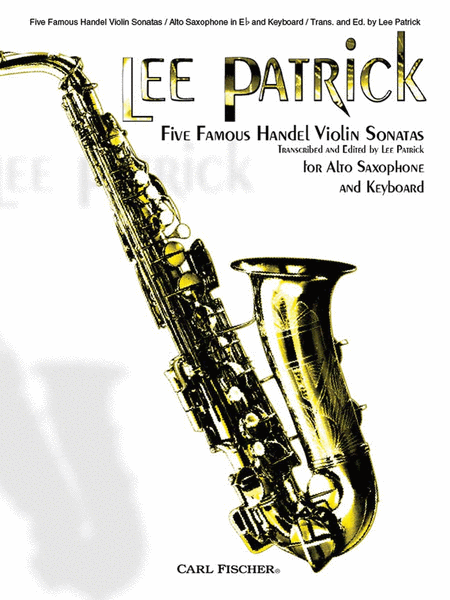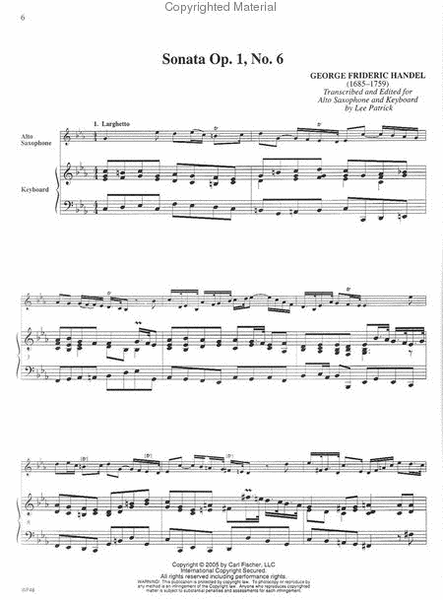Five Famous Handel Violin Sonatas
for Alto Saxophone and Keyboard
-
Ships in 1 to 2 weeks
Details
Description
SKU: CF.WF48
For Alto Saxophone and Keyboard. Composed by George Frideric Handel. Edited by Lee Patrick. SWS+Insert. Lee Patrick. Classical. Set of Score and Parts. With Standard notation. 64+40 pages. Carl Fischer Music #WF48. Published by Carl Fischer Music (CF.WF48).ISBN 9780825853463. UPC: 798408053468. 9 X 12 inches. Transcribed by Lee Patrick.
Taken from G. F. Handel’s 15 sonatas for solo instruments that comprise Opus 1, the five sonatas in this edition have been transcribed and edited by one of today’s most important figures in the classical saxophone world. Meticulously edited, this folio gives intermediate saxophone students strong material for performances and juries. A fine addition to the alto saxophone repertoire!.
Among the many musical treasures left to us by George Frideric Handel (1685–1759) arethe fifteen sonatas for solo instrument and continuo that were collected together as his OpusOne. Composed initially for performance by recorder, flute, oboe and violin players, todaythese sonatas have been adapted for performance on several other instruments that were notavailable in Handel’s day.The early publication history of this set of sonatas raises many questions. The Opus-oneset was first published in Amsterdam in about 1722. About ten years later, John Walsh ofLondon brought out a “more correct” edition. Both editions contain only twelve of thefifteen sonatas, but they are not the same twelve. To add to the confusion, a set of thesepieces edited by the German musicologist Friedrich Chrysander and published in the latenineteenth century contains yet another sonata that is not found in either of the earlierpublications.Within the sets are six sonatas for violin and continuo. According to the conventionalnumbering system of the full set, these are designated as Nos. 3, 10 and 12 through 15. Inthe two eighteenth-century editions, No. 6 was designated as an oboe sonata, but it is knownthat Handel regarded it as a violin sonata as it is considered today. It has always seemed tome that the violin sonatas have more musical meat to them than the other sonatas in the set,and from these seven I have chosen the five that seem the most adaptable for performanceby alto saxophone and keyboard.It is important when editing music to use a system of markings that clearly differentiatesdetails put there by the composer from classifications and suggestions put in the music bythe editor. But when the editor clutters the edition with too many suggestions, he runs thedanger of stifling the interpretative insights that others bring to the music. Consequently, Ihave edited this music with a very light hand.Composers of Handel’s time included very few articulation and dynamic markings in theirscores. This does not mean that every note was tongued or that the music was performedwithout dynamic contrasts. There is plenty of evidence that such was not the performancepractice of the time.There are a few guiding principles that may be helpful when playing this music. In general,appoggiaturas are stressed and slurred to the note upon which they lean. The slur-two,tongue-two articulation so popular in later music seems not to have been used much inHandel’s time. In general, I recommend slurring the sixteenth notes in groups of two orfour. There are a number of passages, such as in the second movement of No. 12 and theopening movement of No. 15, where a tongue-one, slur-three pattern seems appropriate.For the sake of rhythmic clarity, it is rare to slur across a bar line. Slurring across a beat isusually avoided as well.Handel seldom indicated dynamics. Nonetheless, one should always be alert to situationswhere strong dynamic contrasts seem to fit the character of the music. These situationsoften take the form of verbatim or nearly verbatim repetitions of material just presented.Examples of this are found in the opening movement of No. 6, the concluding eight measuresof No. 10, and throughout much of the final movement of No. 13. Other examples can befound throughout this collection. Melodic sequences also present excellent opportunitiesfor dynamic intensification. Handel was famous in his day for composing dramatic musicfor the stage. There is nothing to prevent us from giving life to the drama inherent in thesesonatas.The third movements of most of these sonatas appear at first glance to be technicallyand musically unchallenging. This may be an illusion: the melody part as given to us bythe composer is only a skeleton that the performer is expected to flesh out with melodicelaborations. I have provided examples of such elaborations as ossias with some of thesemovements in this collection. Be mindful that these are suggestions only; there are infinitelymore possibilities.The keyboard parts to these sonatas, like most others from the time of Bach and Handel,were originally figured-bass lines. I am responsible for the realizations in this collection.Handel recycled the final movement of No. 13 as a sinfonia in his oratorio Jephtha (1752).This sinfonia was my model for the realization of that sonata movement.I am greatly indebted to my friend and colleague Loren Tice, who played these five sonataswith me many times and made numerous valuable suggestions along the way. Without hisencouragement, patience and amazing keyboard skills, and profound knowledge of musicalstyles, I doubt that this project would have become a reality.


 Share
Share